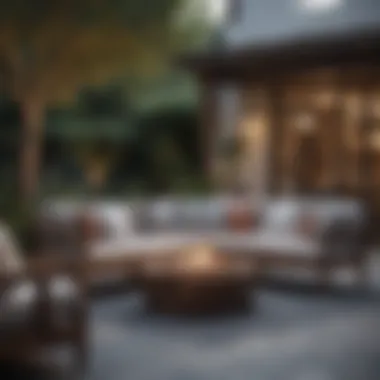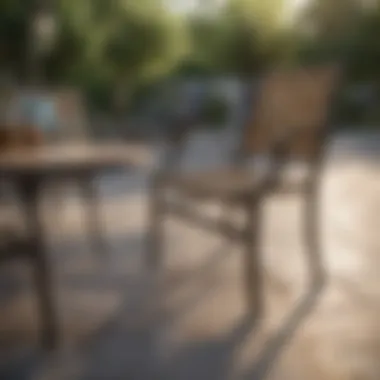Inexpensive Quality Patio Furniture for Every Budget


Intro
Selecting patio furniture is a crucial decision for homeowners who want to make the most of their outdoor spaces. Quality and cost are often at odds; however, it is possible to find affordable options that do not compromise on durability or aesthetic appeal. Proper guidance will help you navigate the marketplace and discern what truly offers value.
This guide focuses on various elements of patio furniture, examining material choices, styles, maintenance practices, and design inspiration. By understanding these factors, homeowners and design enthusiasts can create inviting spaces without straining their budgets.
Design Inspiration
Trending Styles and Themes
When considering inexpensive patio furniture, understanding current trends can inform your selection process. Minimalist designs are gaining traction, featuring clean lines and functional forms. These pieces not only ensure a modern look but also tend to be less expensive due to less material use.
Rustic and farmhouse styles remain popular as well. They often incorporate natural materials like wood and wicker, which provide warmth to outdoor settings. This aesthetic works well in various settings and often comes at a reasonable price. Folding furniture or modular elements can also add a level of practicality while fitting neatly into any outdoor area.
Color Palettes and Combinations
Color plays a vital role in elevating the visual appeal of patio furniture. Neutral tones like beige, grey, and white are versatile and allow for easy integration with the natural surroundings. Additionally, incorporating splashes of color can create a vibrant atmosphere.
Strong hues like teal or coral can be used for cushions or accents, bringing life to your outdoor setting. Selecting colors that complement the seasonal changes can also enhance the overall experience.
"The choice of color in outdoor furniture can dictate the ambiance of the space, influencing its character and usability throughout the year."
Combining various pieces can yield a cohesive look without need for excessive spending. Mixing textures and forms offers depth and surprises to the design, ensuring your space remains inviting.
Material Choices
An essential aspect of selecting inexpensive patio furniture is understanding material properties. Popular materials like aluminum, teak, and resin wicker often emerge as top contenders. Each offers unique advantages.
- Aluminum: Known for its lightweight and rust-resistant qualities, aluminum furniture is ideal for outdoor use.
- Teak: This hardwood is naturally resistant to moisture and insects, making it a durable option. Although typically pricier, buying second-hand can yield bargains.
- Resin Wicker: Often more affordable than natural wicker, resin wicker is UV-resistant and easy to clean, suitable for various climates.
Assessing these materials can help prevent future expenses due to wear and tear, ensuring your patio furniture maintains its quality over time.
Care and Maintenance
Even high-quality inexpensive patio furniture benefits from routine care. Proper maintenance ensures longevity and comfort. Regularly clean your furniture to avoid dirt buildup. For wooden pieces, consider applying a protective sealant to ward off moisture damage.
Storing your furniture during severe weather can prolong its life. Use covers or designate an indoor space for the off-season. These simple practices will enhance both usability and aesthetic appeal, allowing you to enjoy your outdoor experience fully.
Utilizing this guide will facilitate informed decisions about outdoor furniture that not only suits your style and needs but also respects your financial plan. Prioritizing both quality and affordability is not just wise; it is possible.
The benefits of investing time and effort in understanding this topic include:
- High Value: The ability to find furniture that meets desired quality standards at lower prices.
- Long-term Savings: Reducing the need for future re-investment in furniture.
- Aesthetic Appeal: Creating outdoor spaces that reflect personal style without overspending.
Certain factors merit consideration when defining what constitutes inexpensive quality. They include materials used, durability of the products, as well as overall functionality. Choosing wisely in this regard can lead to a satisfying balance between budget constraints and the desire for a pleasant outdoor environment.
Defining Inexpensive Quality
In the realm of patio furniture, inexpensive quality fundamentally relates to the relationship between cost, durability, and aesthetics. It is often thought that quality comes at a premium price, but this is not entirely accurate. Inexpensive quality can be defined as furniture that offers reasonable strength and aesthetic value while remaining budget-conscious. It encapsulates a range of attributes:
- Materials: The type of materials used directly impacts both quality and cost. For example, certain synthetic materials can deliver durability comparable to wood or metal at a lower price point.
- Construction: Look for furniture with robust construction techniques. Mortise-and-tenon joinery, for instance, is often indicative of higher-quality craftsmanship that can stand the test of time.
- Design Adaptability: Quality patio furniture should blend seamlessly with various styles, allowing for versatility in outdoor design.


These factors are crucial for discerning consumers aiming for intelligent purchasing decisions that do not sacrifice quality.
Importance of Choosing Wisely
The importance of choosing wisely cannot be overstated. In a market filled with options, every purchase should be approached with thoughtfulness. Here, several critical considerations emerge:
- Functionality: Consider how the furniture will be used. For example, a dining set may need to endure weather elements while maintaining an appealing look.
- Warranty and Return Policies: Having knowledge of available protections can provide peace of mind when significant investments are made.
- Seasonal Adjustments: Furniture that is easily stored or adapted for seasonal changes often represents smart investment.
Choosing wisely means recognizing the difference between perceived value and actual value in patio furniture. This practice leads to longer-lasting outdoor spaces that reflect both personality and practicality.
Key Materials Used in Patio Furniture
Selecting the right material for patio furniture is crucial. The material affects not only the durability and aesthetics but also the overall usability of the furniture. Understanding these materials helps in making informed decisions that align with personal taste and budget constraints.
Wood: A Classic Choice
Wood has long been a coveted choice for outdoor furniture. It offers natural aesthetics and warmth that can enhance any outdoor setting. Common types include teak, eucalyptus, and cedar. Each of these woods comes with its unique properties.
Teak is renowned for its durability and resistance to the elements. It has high oil content, which helps it withstand moisture. Eucalyptus offers a more budget-friendly option while still providing decent durability. Cedar is light and naturally resistant to decay, making it a popular choice for relaxing patio settings.
When choosing wood, it is critical to evaluate the maintenance requirements. Untreated wood can weather and turn grey over time if left exposed to the elements. However, regular treatment with oil or sealants can prolong the lifespan of the furniture.
Metal: Strength and Versatility
Metal patio furniture is known for its strength and versatility. Materials like aluminum, wrought iron, and stainless steel each offer specific benefits. Aluminum is lightweight and rust-resistant, which makes it ideal for shifting furniture around. Wrought iron, while heavier, provides excellent stability and durability, often enhancing the classic look of outdoor spaces. Stainless steel carries a modern touch, known for its sleek appearance and resistance to corrosion.
Consider the weight of the chosen metal. Some homeowners prefer lightweight options for frequent activity, like moving chairs for gatherings. On the other hand, heavier metal furniture can be beneficial in windy conditions as they tend to stay in place.
Synthetic Materials: Modern Solutions
Synthetic materials, such as resin wicker and polyethylene, have become increasingly popular in outdoor furniture. Resin wicker mimics traditional wicker but offers enhanced durability against weather elements. This material is less prone to fading and cracking, making it a wise investment for outdoor use.
Polyethylene is another synthetic option that stands out due to its resistance to moisture and staining. It requires minimal maintenance, making it appealing for busy homeowners.
When selecting synthetic materials, it is advantageous to choose high-density polyethylene for its ruggedness. This ensures longevity during various weather conditions. In addition, many pieces made from synthetic materials are designed to be lightweight, allowing for easy repositioning when needed.
Choose wisely based on your needs and preferences. Consider factors like weight, durability, and appearance when selecting materials for your patio furniture.
Design Considerations for Outdoor Spaces
Design considerations are crucial for creating an outdoor space that is both functional and aesthetically pleasing. When selecting inexpensive yet quality patio furniture, the design not only affects the overall look of the space but also its usability and comfort. Homeowners should think about how their furniture will integrate within the environment they have created. This can include the layout, size, and style of both the furniture and the surrounding area. Having a clear plan can lead to recommendations that significantly enhance the outdoor experience.
Assessing Your Space
Before investing in patio furniture, it is essential to assess the available space. Start by measuring the area where you plan to place the furniture. Knowing the dimensions helps in choosing items that fit without overcrowding the space.
Consider the following factors:
- Size and Scale: Large furniture can overwhelm a small patio, while small pieces might get lost in a vast area. Striking a balance is important.
- Layout and Flow: Think about how people will move through the space. Create pathways between furniture arrangements to enhance comfort and accessibility.
- Existing Features: Take note of existing elements like decks, gardens, or other architectural features. The furniture should complement these elements rather than clash with them.
Taking time to carefully assess the space can lead to a more enjoyable outdoor experience.
Matching Style with Functionality


Once you understand the space available, it is time to consider how the style of furniture corresponds to its intended use. Each outdoor environment serves its unique purpose, whether for entertaining guests or simply enjoying some solitude. Here are some key points to ponder:
- Purpose: Different activities require different types of furniture. For instance, a dining area may need a larger table and chairs, while a lounge area could utilize smaller, more comfortable seating.
- Material Harmony: Ensure the style of the furniture matches the materials used in the outdoor space. For example, contemporary metal chairs may look out of place on a rustic wooden deck.
- Color and Aesthetics: Choose colors and designs that create a cohesive look. Neutral colors can blend well, while bold colors can offer a pop that draws attention.
Important Consideration: The harmony between style and functionality not only elevates the visual appeal of the outdoor space but also increases its usability.
Ultimately, achieving a balance between style and functionality requires careful thought and planning. Choosing the right furniture enhances the overall experience of outdoor living, making it enjoyable for all who use the space.
Evaluating Durability and Weather Resistance
Understanding Weatherproof Features
Weatherproof features are essential components to consider when selecting patio furniture. Many manufacturers design their products with specific weather conditions in mind. Waterproof materials, for example, can prevent water damage and mold growth. Look for materials such as aluminum or treated wood which are often more resilient against water exposure. Fabrics designed for outdoor use typically feature treatments that repel moisture and resist fading.
There are several weatherproof features to be aware of:
- Sealants: Look for furniture that has been treated with sealants to prevent water penetration.
- Coatings: UV protection coatings help furniture resist discoloration and surface damage from direct sunlight.
- Breathable Materials: This can aid in moisture management, reducing the risk of mildew.
By understanding these features, you can choose patio furniture that truly meets the needs of your specific climate.
Importance of UV Resistance
UV resistance is a critical factor in evaluating patio furniture. The continuous exposure to sunlight can cause significant deterioration in materials. UV rays can break down the chemical bonds in plastics, fading colors, and leading to brittleness. Similarly, wood can warp or crack under consistent exposure without adequate protection.
When selecting furniture, consider the following factors related to UV resistance:
- Material Specifications: Materials that naturally resist UV damage, such as high-density polyethylene or certain woods like teak, may offer better longevity.
- Fabric Treatments: Look for cushions and fabrics that are specifically labeled as UV resistant. These treatments help maintain vibrant colors and prolong usage.
Durability and UV resistance are key in maintaining the quality and appearance of your patio furniture over time. A good evaluation of these elements can save you from recurring costs and enhance your outdoor experience, making it a priority in your selection process.
In summary, understanding weatherproof features and the importance of UV resistance helps ensure you choose patio furniture that will last through changing seasons and maintain its aesthetic appeal. By investing in durable options, you can enjoy your outdoor spaces without frequent replacements.
Budgeting for Patio Furniture
When choosing patio furniture, budgeting becomes crucial. It ensures you can find quality items without draining your finances. Establishing a budget creates a framework for your outdoor furnishing decisions, helping you to prioritize essential features, materials, and aesthetics that align with your outdoor space. Without a thoughtful budget, one could easily spend more on patio furniture than intended, potentially compromising other home improvement plans.
Setting a Realistic Budget
Setting a realistic budget involves analyzing your financial situation and determining how much you can easily allocate for patio furniture. Consider these factors:
- Assess Your Needs: Are you furnishing for casual gatherings or more formal events? The purpose will guide your expenditure.
- Research Prices: Familiarize yourself with the average costs of different materials and styles. This will help you avoid overspending on certain items.
- Allocate for Quality: It is wise to invest in durable materials that may cost a bit more upfront but will save money in the long run due to lesser maintenance and replacement needs.
A detailed budget also accounts for additional costs like delivery and assembly. Remember to leave a buffer in your budget for unexpected expenses, too.
Finding Value in Inexpensive Options
Finding value in inexpensive patio furniture requires keen research and comparison. Here are some effective approaches:
- Evaluate Quality-over-Price: Look beyond just the price tag. Items made from quality materials that are sold at lower prices offer great value. For instance, resin wicker might be more affordable and durable compared to traditional wood.
- Explore Online Platforms: Websites like Wayfair and Amazon often feature sales and discounts, providing access to quality products without overspending. Verify product reviews before making a purchase to ensure they meet your expectations.
- Consider Secondhand Options: Thrift stores, garage sales, and online marketplaces like Facebook Marketplace or Craigslist can yield excellent deals on quality patio furniture. Just be sure to inspect items for any signs of wear or damage.
Remember, value does not strictly equate to low price; it involves finding the balance between cost and quality that meets your needs in outdoor living.
Pursuing a well-thought-out budget can vastly improve the effectiveness of your purchases, ensuring that your outdoor area is both enjoyable and well-furnished without unreasonable expenses.


Where to Shop for Inexpensive Quality Options
When considering the purchase of patio furniture, where to buy can be as critical as the selection itself. A well-informed choice can yield substantial savings and ensure that quality does not take a backseat to price. The aim is to identify places that not only cater to budget-constrained buyers but also maintain the integrity and durability of the furniture. Each shopping avenue has unique advantages, providing potential for value-added purchases.
Local Furniture Stores
Shopping at local furniture stores can be a rewarding experience. These stores often carry a range of items, including clearance and seasonal sales that can lead to significant discounts. Furthermore, supporting local businesses fosters community growth, which can add an ethical layer to your purchasing decision.
Local stores frequently feature unique designs, which might not be available through larger retailers. You also have the advantage of assessing the furniture in person, allowing for a better gauge of comfort and quality. Additionally, store staff can often provide insights into the durability and care of various products, enhancing the overall shopping experience.
Online Retailers
Shopping online allows you to compare prices easily across multiple sites, ensuring you find the best deals. You may also discover flash sales or online exclusives that are more advantageous than in-store prices. However, it is important to pay attention to return policies and shipping costs, as these factors can influence the overall price.
Secondhand and Thrift Options
Exploring secondhand and thrift options can unveil hidden gems. Consignment shops, thrift stores, and online marketplaces like Facebook Marketplace or Craigslist often feature lightly used patio furniture at a fraction of the original price. This method promotes sustainability, effectively recycling quality items that others may no longer need.
However, it is essential to exercise caution. When shopping secondhand, inspect items thoroughly for any damage or wear. Look for pieces that can be easily cleaned or restored, allowing you to maximize your investment.
Maintenance Tips for Longevity
Choosing inexpensive yet quality patio furniture is only part of creating a successful outdoor space. Maintaining that furniture is just as crucial for ensuring its longevity and functionality. Proper maintenance extends the life of your investment and keeps your outdoor area looking its best. This section delves into practical approaches to care, addressing seasonal practices and specific cleaning methods for various materials. By implementing these maintenance tips, you can protect your furniture and enjoy your outdoor space for years to come.
Seasonal Care Practices
Seasonal care is essential for preserving the integrity of patio furniture. Changes in weather can significantly impact its condition. Here are some key seasonal practices to consider:
- Spring Preparation: After winter, inspect for any damages. Clean surfaces to remove dirt and debris. Apply protective sealants if your furniture is made of wood to prevent moisture damage.
- Summer Maintenance: During hot months, ensure that furniture is not left in direct sunlight for extended periods. Use furniture covers when they are not in use. Check for signs of corrosion or fading and treat them promptly.
- Fall Clean-Up: Before winter sets in, clean the furniture thoroughly. Remove leaves and debris that can trap moisture. Store cushions inside or in a dry space to prevent mold growth.
- Winter Protection: If possible, store the furniture indoors. If not, use breathable covers to protect against snow and ice. Keep furniture off the ground to prevent frost damage.
Cleaning Methods for Different Materials
Different materials require distinct cleaning methods. Here are guidelines for common types of patio furniture materials:
- Wood: Clean with a gentle soap solution and a soft cloth. Avoid abrasive pads that can scratch surfaces. Regularly apply wood conditioner or sealant to maintain its finish and protect against moisture.
- Metal: Use a mixture of soap and water to wipe down metal surfaces. Rinse well to prevent rusting. For powder-coated metal, a soft brush might help in removing debris. Protect with rust-resistant sprays when necessary.
- Synthetic Materials: Materials like resin or plastic are generally easier to maintain. A mixture of mild detergent and water can be applied with a sponge. Rinse thoroughly to avoid soap residue. Consider using a UV protectant spray to maintain color.
- Fabrics: For cushions and upholstery, check care tags for instructions. Typically, a gentle cycle wash is sufficient for removable covers. Spot cleaning with a damp cloth can address minor stains.
"Regular maintenance not only enhances the lifespan of your patio furniture but also adds to the aesthetic appeal of your outdoor space."
By following these maintenance tips and adapting them to suit various materials, you can ensure that your patio furniture remains attractive and functional across different seasons. This level of care will reward you with a pleasant outdoor environment conducive to relaxation and enjoyment.
Ending
Making Informed Choices
Making informed choices is a critical element of purchasing patio furniture. Potential buyers must analyze not just the initial cost but also the long-term value of their decisions. Here are some key factors to consider:
- Material Selection: Understanding the different types of materials available is crucial. Wood, metal, and synthetic options all have unique characteristics. For example, while teak offers timeless beauty, synthetic materials can provide enhanced weather resistance without high maintenance requirements.
- Brand Reputation: Researching brands and retailers gives insight into the reliability of the products. Prioritize companies known for quality at affordable prices.
- Product Reviews: Reading customer reviews can highlight strengths and weaknesses of specific items. Users often share valuable experiences that can guide others.
- Suitability to Local Climate: The choice of patio furniture may need adjustment based on climate. Consider furniture that can withstand the elements in your area, such as UV protection for sunny regions or specific materials that resist moisture in humid climates.
By paying attention to these considerations, buyers can optimize their purchases, ensuring lasting satisfaction and enjoyment.
Embracing Outdoor Living
Embracing outdoor living is all about making your space functional and inviting. Quality patio furniture plays a pivotal role in achieving this. When patios are equipped with the right furnishings, they can transform from simple outdoor spaces into comfortable extensions of the home.
The benefits of committing to outdoor living include:
- Increased Social Activities: A well-furnished patio encourages gatherings and festivities, allowing for memorable experiences with family and friends.
- Well-Being: Utilizing outdoor spaces can have positive mental health effects. Time spent outdoors promotes relaxation and appreciation of nature.
- Aesthetic Appeal: Quality furniture enhances the visual appeal of outdoor areas, creating an inviting atmosphere.
In summary, investing in inexpensive yet quality patio furniture is not merely a practical choice but also a wise lifestyle enhancement. This enlightened approach can elevate the enjoyment of outdoor spaces, making them integral to daily living.



